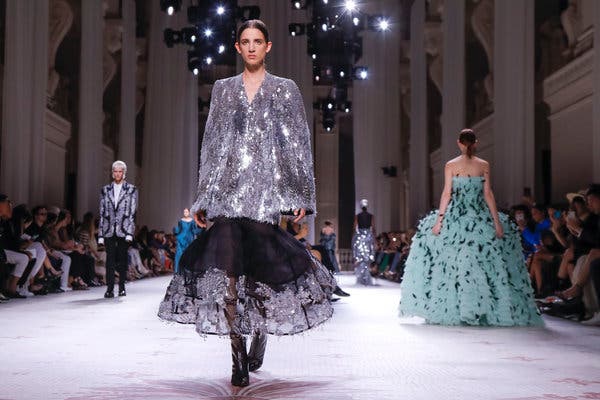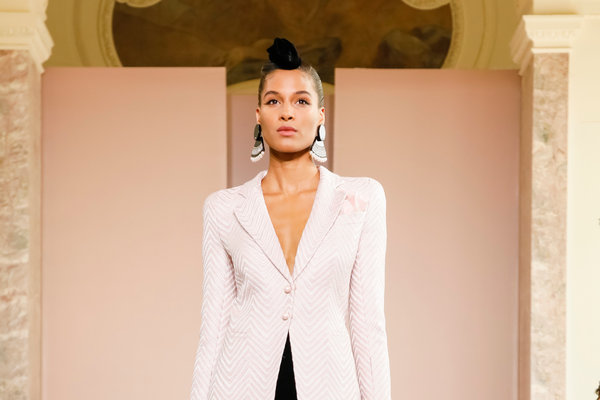
CreditValerio Mezzanotti for The New York Times
PARIS — The night the United States beat Britain at the Women’s World Cup to secure a place in the final, Clare Waight Keller, the Brit at the helm of Givenchy, let loose with a little anarchy in the palace. The events were not necessarily connected, but they had a kind of conceptual resonance. Sometimes you just want to smash some porcelain.
Or, in the case of the couture, some invisibly finished, tailored to the nth degree, every sequin in its place, perfection. When the world doesn’t behave quite as you’d like and the goal posts move, you can either take refuge in beauty and the way things have been done, or create a little ruckus.
Ms. Waight Keller, for one, took the latter approach, imagining a winged creature trailing shreds of feathers and fringe, straps hanging off parachute puffs of pink taffeta and iridescent green jacquard, as she smashed her way through a host of classic chateaus (in reality it was the Musée des Arts Décoratifs, part of the Louvre complex, one of the most elaborate palaces in France). Fringed, shredded houndstooth and tweed were inspired by black and white tile flooring; glinting silver sequin tunic capes and jackets provided a jolt of silverware (silverwear); mint green and black feathered fantasias escaped from the aviary; and asymmetric ball gowns of beaded fringe and under-feathers, tulle and lace, teetered alluringly close to the edge of coming undone.
The collection was about as cool as couture gets in its elaborate insouciance and it had an energy that has been largely missing in a week where safe and stately has been the rule.
See, for example, the “moment of peace” described by Giambattista Valli as he stood amid his collection in the soaring public rooms of the Hotel Shangri-La (a name that is a metaphor if there has ever been one) where he had opted to hold a static exhibition using mannequins instead of a live runway. Amid the constant treadmill of his working life — a collaboration with H & M, a wedding dress for Charlotte Casiraghi of Monaco — it was easy to understand the appeal of a time out.
His featured a panoply of greatest hits — the enormous pastel tulle confections that have been his showstopper signatures; the high-low Watteau party-dress taffetas that rise to the thigh in front and sweep through a doorway in the back; the little 1960s shifts embroidered with filigree orange blossoms; the strapless empire-waist columns bursting with peony blooms from rib cage to ankle — all placed, if not on a pedestal per se, then on an assortment of platforms. The physical, as opposed to the virtual kind.
Or see Giorgio Armani’s measured Privé parade down a memory lane veiled in sparkles and winking fairy lights. That led to a once-upon-a-time 1980s “folk” moment (or so said the show notes, though … erm … remember that one? Me neither) of black and white and pink polka dots, lamé pajama pants with boss-lady jackets, and trumpet-skirt evening silhouettes with tiny little tops in candy floss shades, all of it covered in diaphanous layers of chiffon and crystal mesh and diamanté -speckled tulle, so the effect was a little fuzzy and soft focus. The models even paused at times to do a series of department store show twirls.
It’s been a while since anyone had seen that — just as it’s been a while since the couture had seen the kind of front-row celebrities Mr. Armani brought in for his second showing: Nicole Kidman and Keith Urban were there; so were Zendaya, Olivia Hamilton, Alexander Skarsgard and Damien Chazelle, among others. Up until then, Celine Dion had been the main paparazzi magnet of the season, though Nick Jonas, Priyanka Chopra and Gal Gadot had put in appearances at Dior. Oh, hello famous people! We’re still playing that game?
Not everyone, to be sure. Not Ms. Waight Keller, and certainly not John Galliano at Maison Margiela, who has been merrily rewriting all the rules.
“I feel we are in a survival mood,” he said in his now-trademark preshow podcast (podcast! case in point). “And we have to revert back to trusting our own instincts.” His instincts being, as he said, “impulsive and anarchic” (that word again).
He has been busy taking his shears to traditional definitions — of gender, of who wears what, of where pants go and what constitutes a dress — chopping them up and remaking them into something else entirely, something that often defies categorization, but is nevertheless awfully interesting to look at.
So as projections of the artist Katerina Jebb’s photo scans of nude body parts (feet and arms and breasts and groins) flowed across the plastered walls of the Margiela ateliers and were reflected in a mirrored runway, and as audience members stood clustered in the center, because standing was part of the experience, out came men and women in jackets patterned with multiple peekaboo holes, like photo negatives of polka dots cut out to reveal what was underneath. They were paired not with trousers but vests that had been turned into shorts, their straps dangling down like garter belts over high-heel boots.
The missing pants, meanwhile, had been blown up and sliced open, migrated into strapless gowns belted beneath the breast and disgorging silk linings, worn over flesh-colored corsets, oft exploding out into trains and bustles, even wings, at the back. Translucent organza was printed with faux reptile skin or men’s wear fabric patterns and layered to create an impression just this side of discombobulating. You think you know what you are looking at; now, you realize you don’t.
In it all, you could sense the familiar, shimmering just out of reach. Such is the state of things. It was hard not to get a kick out of it.










